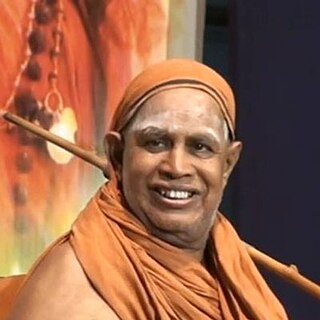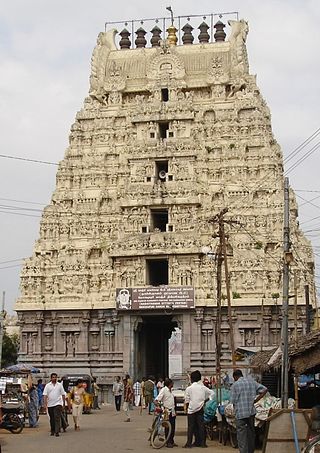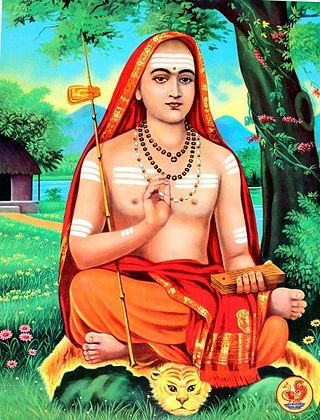
Muthuswami Dikshitar (Mudduswamy Dikshitar) (IAST: muttusvāmi dīkṣitar, 24 March 1776 – 21 October 1835), mononymously Dikshitar, was a South Indian poet, singer and veena player, and a composer of Indian classical music, who is considered one of the musical trinity of Carnatic music. Muthuswami Dikshitar was born on 24 March 1776 in Tiruvarur near Thanjavur, in what is now the state of Tamil Nadu in India, to a family that is traditionally traced back to Virinichipuram in the northern boundaries of the state.

Shankaracharya is a religious title used by the heads of amnaya monasteries called mathas in the Advaita Vedanta tradition of Hinduism. The title derives from Adi Shankara; teachers from the successive line of teachers retrospectively dated back to him are known as Shankaracharyas.

Jagadguru Sri Jayendra Saraswathi ShankaracharyaSwamigal was the 69th Shankaracharya Guru and head or pontiff (Pïțhādhipati) of the Kanchi Kamakoti Peetham. Subramanyam Mahadeva Iyer was nominated by his predecessor, Chandrashekarendra Saraswati, as his successor and was given the pontifical title Sri Jayendra Saraswathi on 22 March 1954.
Sri Kanchi Kamakoti Peetham, also called the Sri Kanchi Matham or the Moolamnaya Sarvagnya Peetham, is a Hindu religious center of Vedic learning, located in Kanchipuram, Tamil Nadu. It is located near the Kamakshi Amman Temple of the Shaktism tradition, which also contains a shrine dedicated to the final resting place of the Advaita Vedanta teacher Adi Shankara.

Jagadguru Shri Chandrasekharendra Saraswati Shankaracharya Mahaswamigal also known as the Sage of Kanchi or Mahaperiyavar was the 68th Jagadguru Shankaracharya of the Moolamnaya Saravjna Kanchi Kamakoti Peetham. Mahaperiyavar's discourses have been recorded in a Tamil book titled "Deivathin Kural".

The Kamakshi Amman Temple, also known as Kamakoti Nayaki Kovil, is a Hindu temple dedicated to the goddess Kamakshi, one of the highest aspects of Adi Parashakti, the supreme goddess in Shaktism. The temple is located in the historic city of Kanchipuram, near Chennai, India.

Manamadurai is a Municipality Town in Sivaganga district in the Indian state of Tamil Nadu. Manamadurai falls under Manamadurai Legislative assembly. It is a river based settlement town. River Vaigai makes its way through the town bifurcating it into two parts.
Maharajapuram Santhanam, was an Indian Carnatic vocalist. He was awarded the Madras Music Academy's Sangeetha Kalanidhi in 1989.

S. Sowmya is a Carnatic music vocalist. She learnt music initially from her father Srinivasan, and later from S. Ramanathan and Smt.T. Muktha. She received the Sangeetha Kalanidhi title by Madras Music Academy in 2019 and the Isai Perarignar by the Tamil Isai Sangam in 2022. She was appointed by the Govt of Tamil Nadu as Vice Chancellor of the Tamil Nadu Dr J Jayalalithaa Music & Fine Arts University on April 8, 2022, for a period of three years.

Jagadguru Sri Shankara Vijayendra Saraswathi Swamigal is the 70th Jagadguru Peethadipathi of Kanchi Kamakoti Peetham, Kanchipuram. He became the Peetadhipathi of the Kanchi Kamakoti Peetham following the Videha mukti of Sri Jayendra Saraswati, the 69th Pontiff, on 28 February 2018.
Chingleput Ranganathan was a classical Carnatic vocalist and Guru.

Balakudru Shrimatha is the Gurupeetha for the brahmins of South Canara District mainly Shivalli sects who follow Advaitha philosophy. The ashram is headed now by Shri Shri Narasimha Ashrama Swamiji, who also selected his successor-designate Shri Vasudeva Sadashiva Ashrama Swamiji on 22nd Nov 2024 in Bengaluru in the traditional manner, in a ceremony conducted by highly respected Vedic scholars in the presence of various other Math heads like Hariharapura and Kailash Ashrama and representatives from Moolamnaya Sarvajna Shri Kanchi Kamakoti Peetham.

Patri Satish Kumar is an Indian Carnatic musician who is an exponent of the Mridangam, an Indian percussion instrument. He has been conferred with the prestigious Sangeet Natak Akademy award by the Government of India in the year 2020. Patri is also the recipient of the Global Peace Award for the year 2018 from the Universal Socio Cultural Association in collaboration with Philanthropic Society India – International.

The Advaita Guru-Paramparā is the traditional lineage (parampara) of divine, Vedic and historical teachers of Advaita Vedanta. It begins with the Daiva-paramparā, the gods; followed by the Ṛṣi-paramparā, the Vedic seers; and then the Mānava-paramparā, with the historical teachers Gaudapada and Adi Shankara, and four of Shankara's pupils. Of the five contemporary acharyas, the heads of the five Advaita mathas, four acharyas trace their lineage to those four pupils and one to Adi Shankara himself.
Nerur is one of the villages in Karur taluk in Karur District in Tamil Nadu State. Nerur is located 10 km distance from Karur. It is 323 km far from Chennai. This village is known for the Samadhi of a 17th-century Hindu saint, Sri Sadasiva Brahmendra.

Uttarāmnāya Śrī Jyotish Pītham or JyotirMath is one amongst the four cardinal pīthams established by the Ādi Śaṅkara 1300 years ago to preserve Hinduism and Advaita Vedānta, the doctrine of non-dualism. Located in the city of Joshimath, Chamoli district, Uttarakhand, India, it is the uttarāmnāya matha or Northern Āmnāya Pītham, amongst the four Chaturamnay Peethams - Kalady Kerala, birthplace of Adi Shankara with the others being the Sringeri Śārada Pīṭhaṃ (Karnataka) in the South, Dvārakā Śāradā Pītham in the West and Purī Govardhanmaṭha Pīṭhaṃ in the east. Its appointees bear the title of Shankaracharya. It is the headquarters of Giri, Parvata & Sagara sects of the Dasnami Sampradaya. Their Vedantic mantra or Mahavakya is Ayamātmānam brahma and as per the tradition initiated by Adi Shankara it holds authority over Atharva Veda. The head of the matha is called Shankaracharya, the title derives from Adi Shankara.
Atma Bodhendra Saraswati was the 58th Pontiff of the Kanchi Matha from 1586 AD to 1638 AD. He was a native of Vridhachalam, Tamil Nadu. He was born in the year 1586. His pre-monastic name was Visvesvara. In some texts name him as Vishwakendra Saraswati or Girvanendra Saraswati. Sri Neelakanta Dikshitar in Guru Ratna Malika praised him as Girvanendra Saraswati of Kanchi Kamakoti Peetam. He toured south India extensively and stayed at Benares. He wrote a commentary on the Vedic Sri Rudram. It was Atma Bodhendhra who instructed the great Avadhuta Sri Sadasiva Brahmendra to write the Guru ratna Malika stotram on the Gurus of the Kanchi Kamakoti Peetam. For Sadasiva brahmendra saraswathi and Atma Bodendra Saraswathi, the common guru is 57th Pontiff of Kanchi Kamakoti Peetam, Sri Paramasivendra Saraswathi who attained siddhi at Tiruvengadu. Atma Bodhendra Saraswathi is the immediate guru of Bodhendra Saraswathi, the 59th pontiff of Sri Kanchi Mutt who attained siddhi at Govindapuram, near Kumbakonam.

Sattanatha Muthiah Ganapathi, popularly known as S. M. Ganapathi sthapathi, was an Indian architect and builder (sthapati) of traditional Hindu temple architecture. He was known for his contribution in saving 48 archaeologically important temples near the Nagarjun Sagar reservoir from submergence. Orirukkai Manimantapam, Ramalayam and Kalyana Mandapam at Bhadrachalam and the Mahamantapam of the Badrinath Temple are some of his notable creations. The Government of India awarded him the fourth highest civilian award of Padma Shri in 1990.

According to the Kanchi Kamakoti Peetham tradition, Vyasachala Mahadevendra Saraswati was its 54th Pontiff from 1498 to 1507AD. He was the son of Kamesvara and Kamalamba who belonged to Kanchi. His pre-sanyasa name was Kuppanna and his guru was Purnananda Sadasivendra Saraswati. He is the author of Vyasachala Sankara Vijaya. He attained mukti at Vyasachala on the first day of the dark fortnight of Ashada in the cyclic year Akshaya. The Acharyal has been described as great tapasvi and besmeared with holy vibhuthi and engaged himself in Shiva aradhana. The jeeva samadhi of Vyasachala Mahadevendra Saraswati is located in Sri Nallinaikeshwarar temple Ezhichur which is 55 km from Chennai. The Shiva Linga was worshipped by Surya and Chandra Bhagavan. There is a temple pond which was created by Surya Bhagavan for worshipping Lord Nallinakeshwarar. It's said that 7 Siddhas pray to the Shiva Linga in the form of snakes and one who is steeped in devotion can have the good fortune of having darshan of them. Acharyal Vyasachala Mahadevendra Saraswati attained videha mukti and went into Agni Mudra through which he was immediately transformed to sacred vibhuthi. It's said that one should chant Pancaksara Mantra with devotion to have darshan of the acharya in person or through speech or visions. The sacred vibhuthi provided by the priest should be only used during the evening and one should take care not to commit any aparadha or any sin. After his mukti, the disciplic succession was carried over by Chandrachudhendra Saraswati II,
Thavil Kongampattu A V Murugaiyan is a thavil player from the Puducherry Union Territory in India.


















